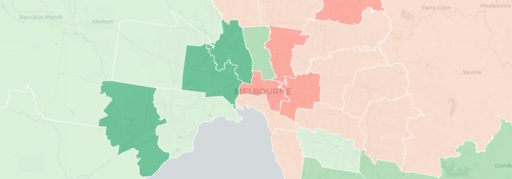The exact record will depend on the final results, but it seems likely that this election result will produce more seats than the 90 seats won by Tony Abbott in 2013. There’s a chance Labor could surpass John Howard’s result in 1996, although I don’t think they’ll quite get there. As for Labor results, this is their best result in seat terms since 1943, and I don’t think any other result before that was any better.
For the Coalition, this looks like the worst result for any major party since 1943, even producing a lower seat proportion than Whitlam’s Labor in 1975. Of course the ballooning size of the crossbench means the defeat of the Coalition is a bit more impressive than Labor’s victory – an exaggerated version of the mismatch we saw in 2022.
For this whole campaign we have been looking at the declining major party votes, and what is amazing is that Labor has achieved this enormous victory while barely raising their primary vote.
…
The final point I want to touch on is the Greens’ performance. At the moment it looks like they will scrape by in Melbourne and potentially win other seats like Wills and Ryan. Their result wasn’t particularly impressive, but I want to emphasise how much they are victims of the electoral system. Nationally the Greens vote is steady, just over 12%, and part of the story is that the Greens suffered primary vote swings in many of their best seats while gaining votes elsewhere. The map at the end of this post makes this very clear in cities like Melbourne and Brisbane, although you don’t see it in the same way in Sydney.
But in a number of their seats, their defeat did not primarily come due to a dropping primary vote, but a rearrangement of their opponents. In Brisbane and Griffith, the rising Labor vote pushed the LNP into third, and thus LNP preferences will elect Labor.
It’s a perverse part of our system that the most conservative voters decide who wins in some of the most progressive seats. Elizabeth Watson-Brown likely will survive while Max Chandler-Mather will be defeated because she represents a more conservative seat where the LNP is the main opponent.
And this is a challenge for the Greens because so many of their best seats are now Labor vs Greens contests where Labor will easily win the 2CP on Liberal preferences.



Your idea would result in a 225 seat house. Mine would be 250. Not a significant difference IMO.
I actually most of all would like to see a move to MMP, the system used (with some minor differences) in NZ and Germany. Where you elect 1 per division locally, and also vote for a party, with the party vote being roughly 50% of the total seats in Parliament, and used to make the total Parliament proportional to the will of the people. The biggest differences I would like compared to the Kiwi & German system is to let you give a second preference for the party vote, used only if your first choice doesn’t reach the 5% minimum threshold to get any seats, and to choose MPs in the proportional system based on nearest loser, rather than by a party-provided list, so if a party deserves 1 extra seat based on its party vote, the candidate from that party that gets the seat is the one that got 49% of the seat vote, rather than being the person who was pre-selected by the party to get the highest priority.